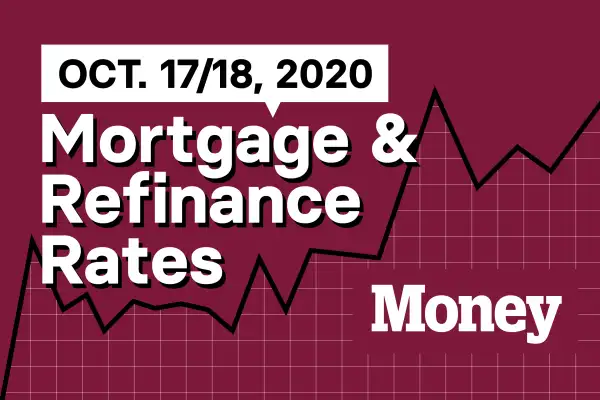Today's Mortgage and Refinance Rates for October 17 and 18

The average rate for a 30-year fixed-rate purchase mortgage was 3.482% on Thursday. The average rate for a 30-year refinance was 4.4%.
Money's most recent mortgage rates include data from over 8,000 lenders across the United States and are updated daily. The rates include points and represent what a borrower with a 20% down payment and 700 credit scores — roughly the national average FICO score — would have been quoted.
| 30-year fixed-rate purchase mortgage |
| 3.482% |
| Rate of October 15, 2020 |
Mortgage rates vary from state to state. On Thursday, borrowers in Kentucky were quoted the lowest mortgage rates — at 3.299%. People looking for mortgages in Nevada saw the highest average rate at 3.833%. Nationwide, borrowers with the highest credit scores, 740 and above, were quoted rates averaging 3.002%, while those with credit of 640 or below were shown rates of 4.75% — a 1.748 percentage-point spread.
You may be able to negotiate a lower rate if you shop around or if you have other accounts with the lender. (Money's picks for the best mortgage lenders are here.) Currently, some banks are hiking up advertised rates to keep demand in check, so you may be offered a lower rate if you reach out directly.
Freddie Mac's widely quoted Primary Mortgage Market Survey put rates at 2.81% with 0.6 points paid for the week ending October 15, a new record low. The mortgage purchaser's weekly survey reflects borrowers who put 20% down on conforming loans and have excellent credit.
Refinance rates today
Money's most recent survey also shows that the offered rate for a 30-year refinance for someone with a 740 credit score was 3.729% on Thursday. Last October, the average mortgage rate (including fees) was 3.859%.
| 30-year fixed-rate mortgage refi |
| 3.729% |
| Rate of October 15, 2020 |
A homeowner with a $200,000 mortgage balance currently paying 3.859% on a 30-year could potentially cut their monthly payment from $939 to $927 by financing at the current lower rates. To determine if it's worth it to refinance your mortgage, also consider the closing fees you paid on your current mortgage, how much your new lender is charging and how long you have left on your loan term. (Our picks for the best lenders for refinancing are here).
The Week in Review
There was good news for homebuyers throughout the week, as the housing market remains strong despite the ongoing effects of the COVID-19 pandemic.
The biggest plus for homeowners and buyers came on Thursday when Freddie Mac announced that the average interest rates on a 30-year mortgage had dropped 0.6 percentage points to a new low of 2.81%. It is the tenth time this year that mortgage rates set a new record. Thanks to low rates, the number of home purchases and loan refinances have been at above-average levels since lockdown restrictions began to ease this summer.
Meanwhile, the Mortgage Bankers Association reported that the volume of mortgage loan applications modestly decreased by 0.7% for the week ending October 9. Purchase loans were down 1% while refinance loans dipped by just 0.3%. Both types of loans remained above last year's levels, up 24% and 44% respectively.
Mortgage applications for newly-built homes increased 38% year-over-year in September, coming in at a seasonally adjusted annual rate of 869,000 units, according to the MBA. Although sales were up from last year, there was a slight month-to-month decline between August and September of 02.%.
The number of loans in forbearance also dropped by 49 basis points to 6.32% of all mortgages. The number of homes taking advantage of the payment deferral plans is now 3.2 million — down from a peak of 4.3 million in June — according to the MBA.
The large decrease is due in part to the expiration of the original six month forbearance period established by the CARES Act. Homeowners with federally backed mortgages can request a six-month forbearance extension if they are still impacted by COVID-19. However, borrowers must reach out to their services to ask for extension, meaning the large drop may be inflated by people not knowing they need to take action.
On a more positive note, the MBA noted that two-thirds of homeowners that have exited their forbearance plan have been able to resume or continue their pre-pandemic monthly mortgage payments.
The number of mortgage loans in some stage of delinquency spiked during the month of July, representing 6.6% of all loans, according to real estate data provider CoreLogic.
Serious delinquencies — those that are 90 days or more past due — made up 4.1% of all loans, the largest share since April of 2014. Loans that were in the early stages of delinquency made up 1.5%, down from a peak of 4.2% reached in April of this year. Loans that were between 60 and 89 days past due decreased from 2% on all loans in May to 1% in July. Meanwhile, the number of loans in some stage of foreclosure was just 0.3% — the lowest rate for any month in 21 years due in part to bans on foreclosures during the pandemic.
It seems that home sellers may finally be trickling back into the market, as the decline in the number of homes for sale and new listings appears to be slowing down according to a report by Realtor.com. The total housing inventory for the week ending October 10 was down 38% from the same week last year. However, it is the fourth week in a row where the inventory deficit has either stayed the same or improved slightly. New home listings were down 5% year-over-year, but better than the 7% deficit of the previous week.
However, wildfires are wreaking havoc on some West Coast housing markets. Realtor.com estimates that more than 12,500 homes are at risk from fires in the states of California and Oregon, representing a total value of $12.5 billion. California is at the highest risk, with 12,000 properties in danger, representing an estimated value of $9.4 billion. The state has already lost 4 million acres of land, eclipsing the previous high of 1.8 million acres.
In another sign of an unusual real estate market, the sale of luxury homes soared during the third quarter, increasing 41.5% year-over-year, according to real estate brokerage Redfin. Luxury home sales usually take a hit during a recession, as wealthy Americans tighten the purse strings. However, low mortgage rates, remote work and a strong stock market have made purchasing a home during this recession a no-brainer. Meanwhile, median-priced home sales increased by just 3%, while affordable home sales decreased by 4.2%.
At the same time, homebuyer demand remains strong. Homes were selling in 52 days, two weeks faster than they did during the same period last year. The median listing price rose to just over $350,000, but home price growth decelerated slightly, increasing by 12.2% compared to last week's 12.9%, according to Realtor.com.
Interest in newly-built homes remains high, as the home sales outpaced construction starts by the widest margin in history, according to the National Association of Home Builders. Compared to last year, homebuilders were selling 69% more homes that hadn't been started yet. There currently is a 3.3-month supply of newly-built homes and a 2.2-month supply of existing homes available on the market right now.
On the labor front, there were 898,000 new initial claims for unemployment for the week ending October 10, according to the Department of Labor. This number was well above the expected 830,000 claims. Continuing claims for the week ending October 3 were down over 1 million to 10,018,000. The seasonally adjusted insured unemployment rate went down to 6.8%.
More from Money:
The Home Buyer’s Dilemma: As Mortgage Rates Fall, House Prices Soar out of Reach
The Overlooked Reason It’s so Hard to Buy a Home in 2020
Bidding Wars Are Back. Here’s How to Win Your Dream Home
Rates are subject to change. All information provided here is accurate as of the publish date.
